AEG Identifikationssysteme AREK1-1 RFID Reader User Manual ARE K1 Hardware Manual english 10
AEG Identifikationssysteme GmbH RFID Reader ARE K1 Hardware Manual english 10
Contents
- 1. user manual
- 2. User manual II
- 3. user manual ext antenna
User manual II
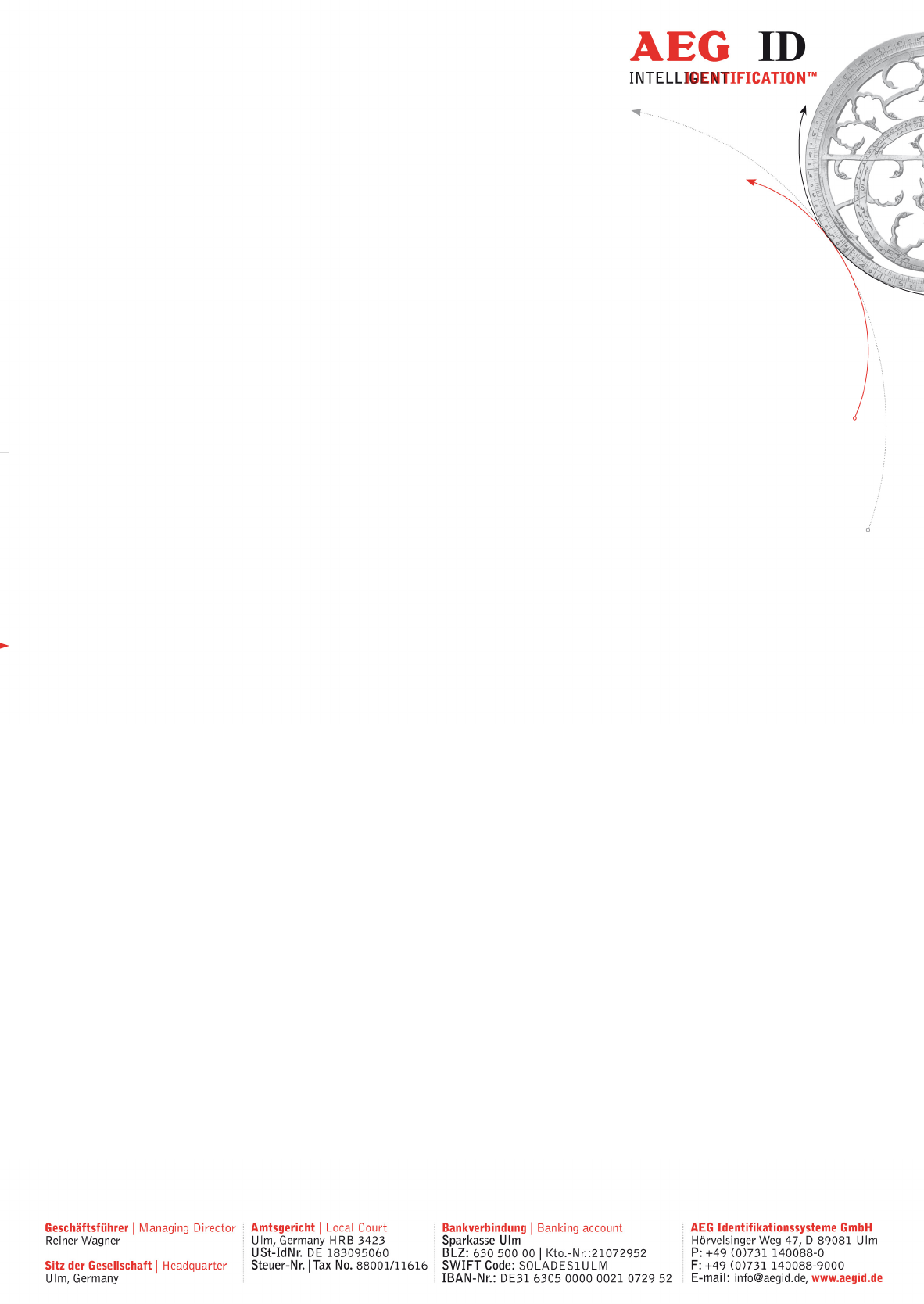
ARE K1 / RS232
ARE K1 / RS232ARE K1 / RS232
ARE K1 / RS232
Transponderreader for trovanTM
transponders for Industrial Applications
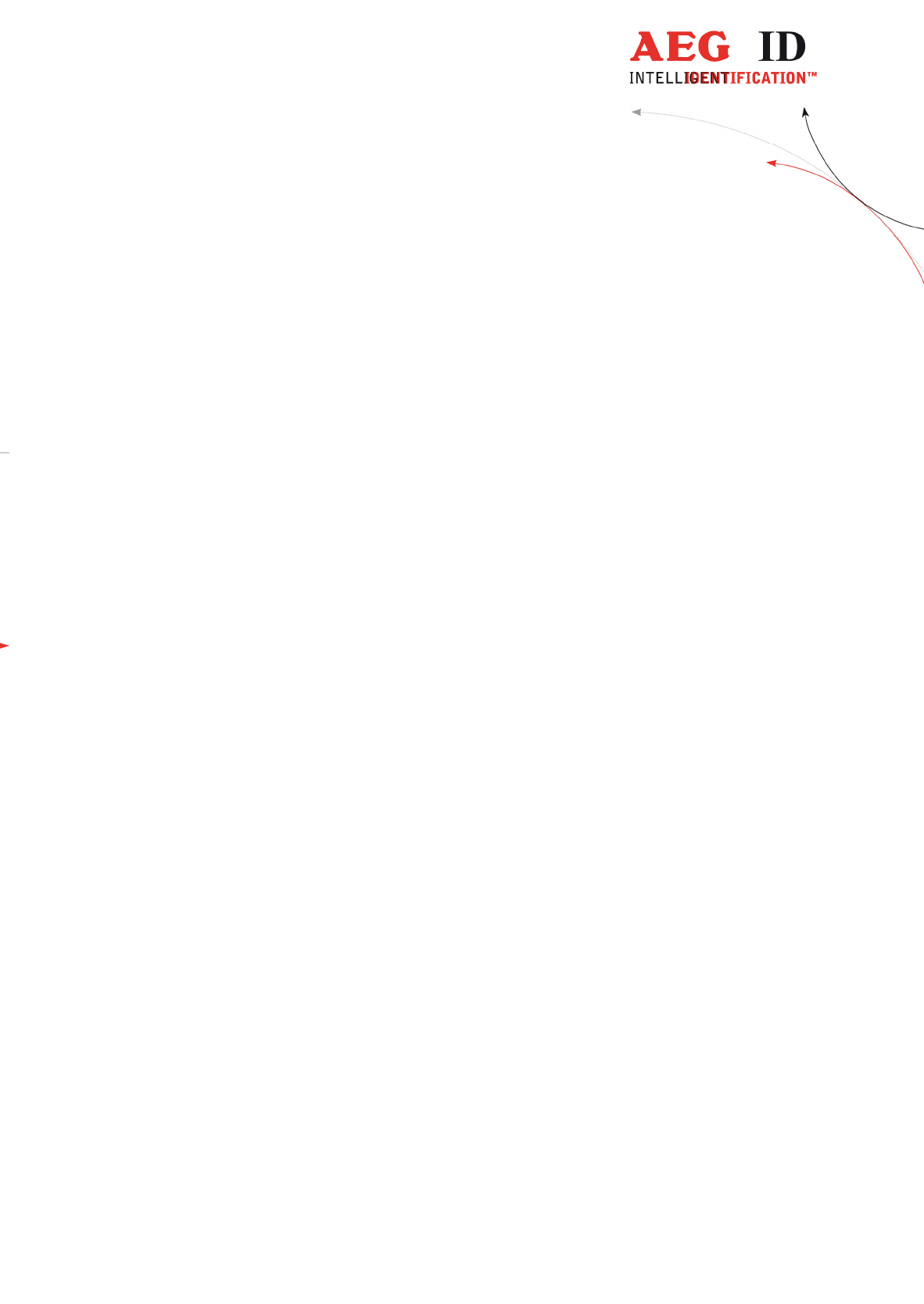
--------------------------------------------------------------------------------2/13--------------------------------------------------------------------------------
TRANSPONDERREADER FOR TROVANTM 1
TRANSPONDERS FOR INDUSTRIAL APPLICATIONS 1
1 INTRODUCTION 4
2 TECHNICAL DATA 4
2.1 Mechanical characteristics 4
2.2 Outline dimensions 5
2.3 PCB of the ARE K1 6
2.4 Connection characteristics of the digital inputs 6
2.5 Connection characteristics of the relay outputs 6
2.6 Pin configuration of the RS 232 interface 6
2.7 Antenna cable 6
2.8 Pin Configuration of the terminal blocks (for antenna, power lines, etc.) 8
2.9 DIP-Switches 8
2.10 LED´s 8
3 FIRMWARE 9
4 PUTTING INTO OPERATION 10
4.1 Putting into operation for the first time 10
4.2 Trouble shooting 10
5 ANTENNAS 11
6 WARNINGS AND CAUTIONS 11
7 FCC INFORMATION 12
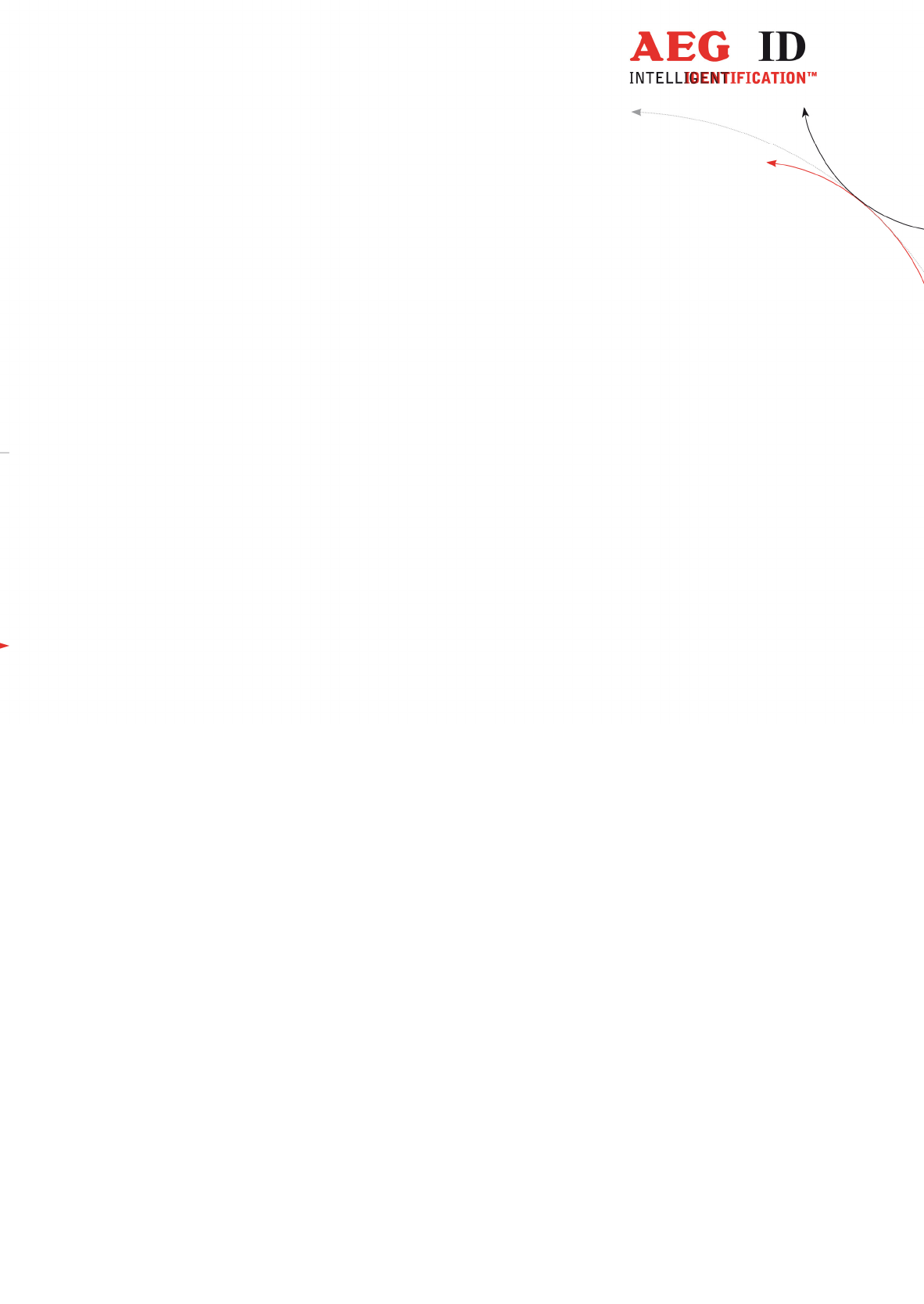
--------------------------------------------------------------------------------3/13--------------------------------------------------------------------------------
8 NOTIFICATION OF CHANGES 13
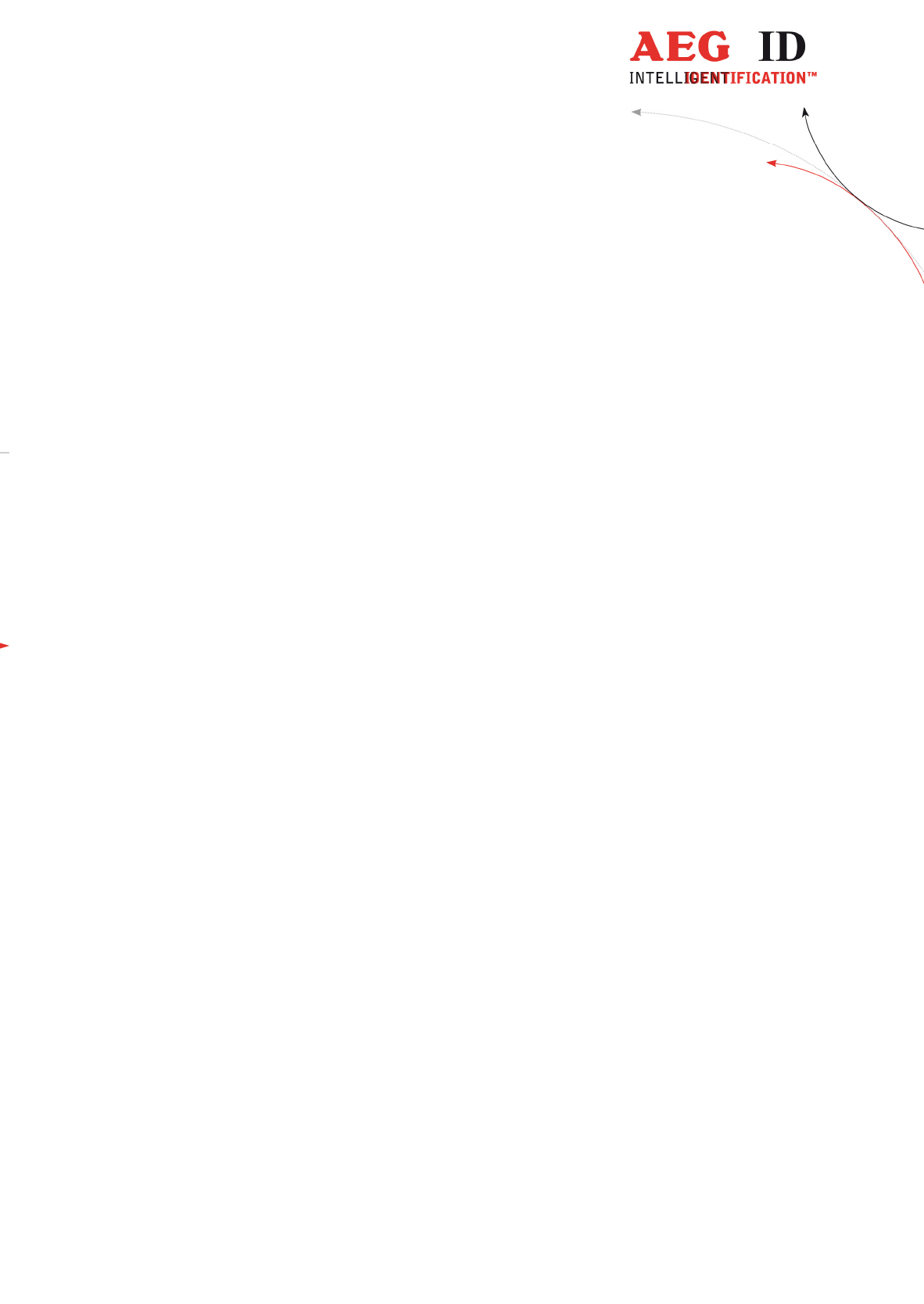
--------------------------------------------------------------------------------4/13--------------------------------------------------------------------------------
1 Introduction
The reader is designed to read trovantm transponders. It is a robust device for industrial applications. It is es-
pecially suited for large reading ranges. The adaption to the individual needs can be performed by selection of
the most optimal antenna.
The wide range of applications for this device includes for example:
Production control in car assembly and paint shop, barrel logistics, bin identification, skilift management, etc.
Typical reading range is between 20 cm to 70 cm depending on the type of antenna and transponder.
2 Technical data
2.1 Mechanical characteristics
The scanner is integrated into a alloy housing with PG threads for the cable connection. When assembled cor-
rectly the housing is good for wet environment according to IP 65. The cable connection is done at the inside
of the housing with help of the terminal blocks.
The dimensions of the housing are 220 x 122 x 80 mm
The weight is approximately 1,8 kg
Storage and operation temperature: -20° till +70°C
Humidity; 95% at +50°C (not condensing)
70% at +70°C (not condensing)
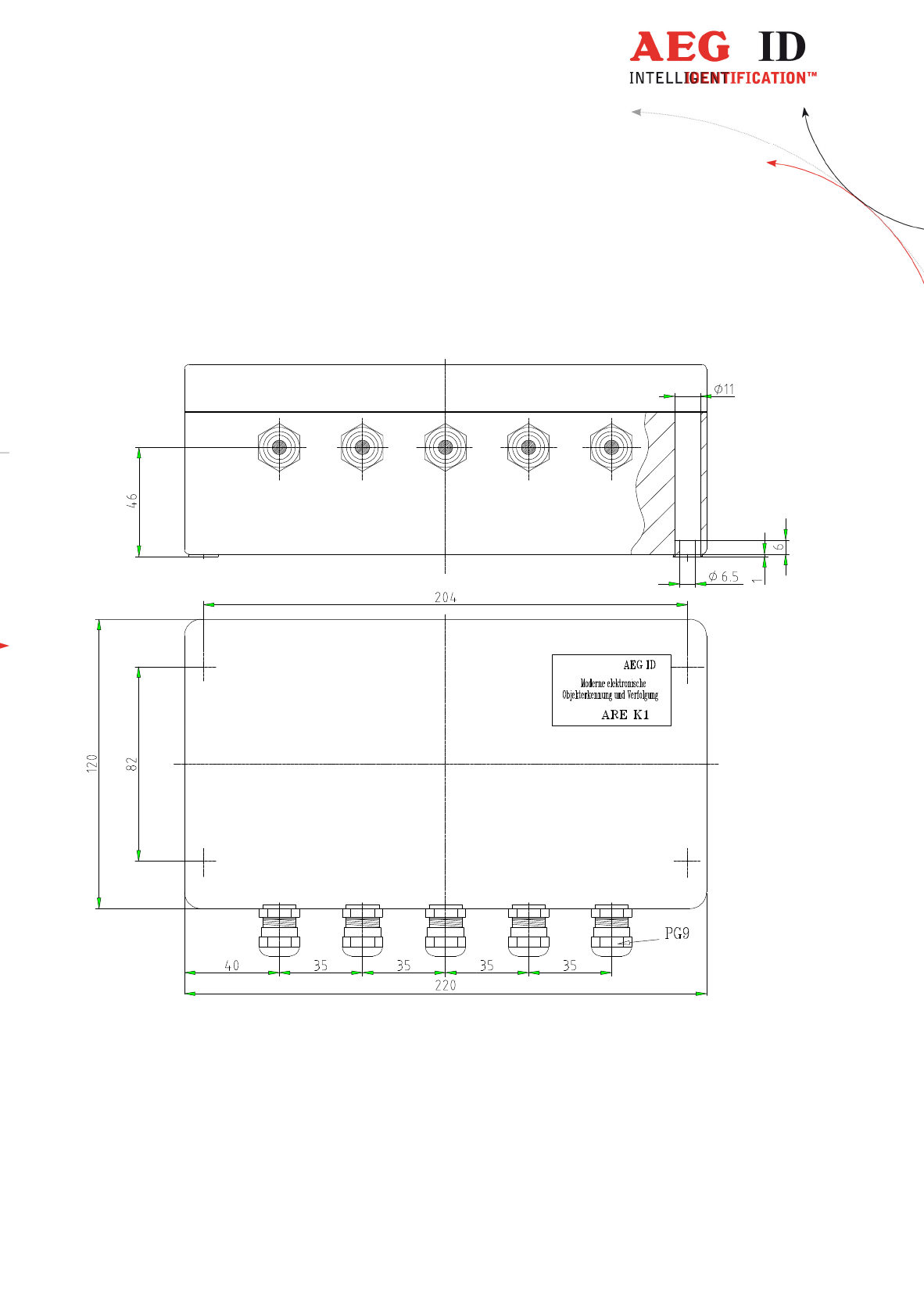
--------------------------------------------------------------------------------5/13--------------------------------------------------------------------------------
2.2 Outline dimensions
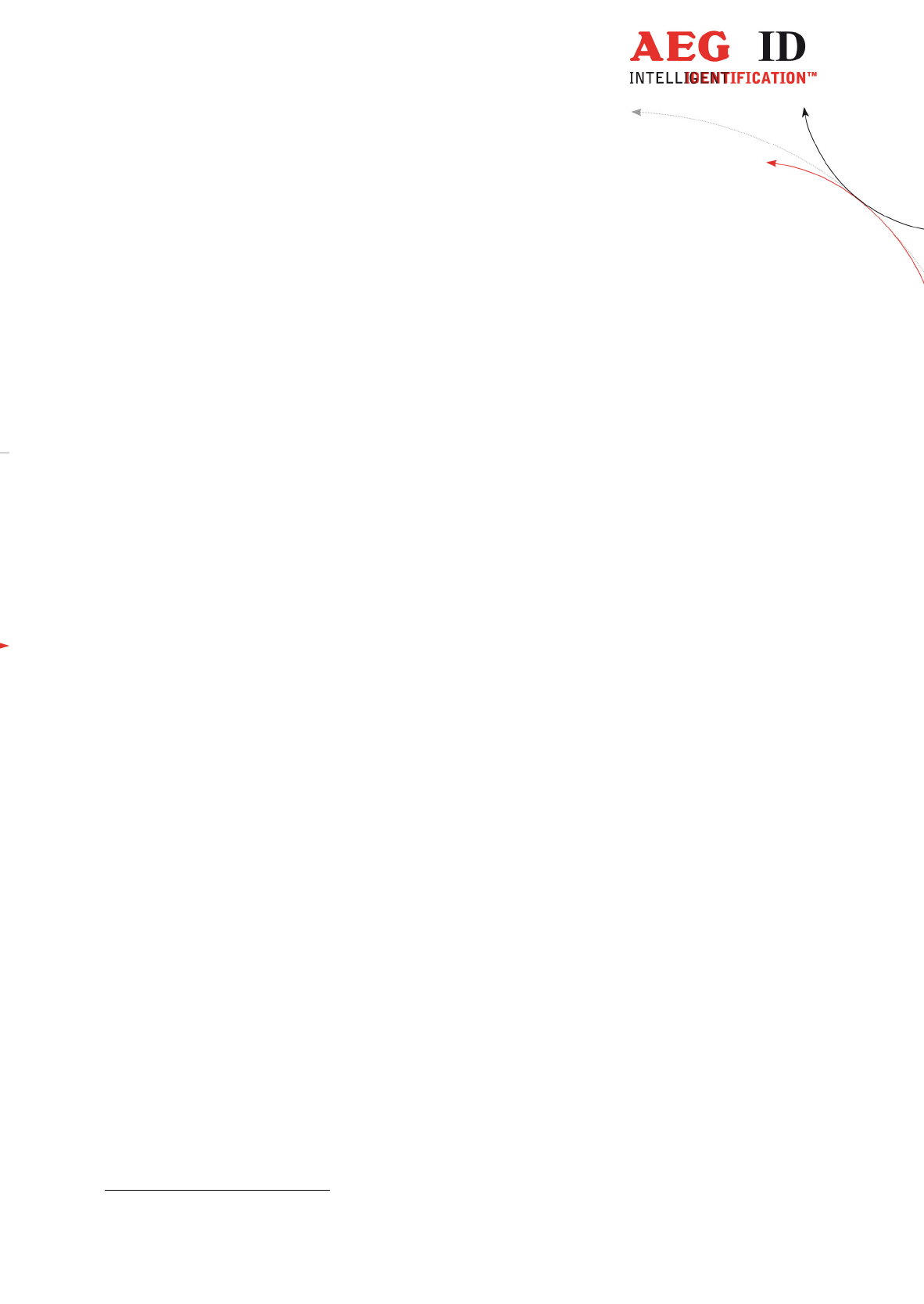
--------------------------------------------------------------------------------6/13--------------------------------------------------------------------------------
2.3 PCB of the ARE K1
Input power: 24 V(18....30V)
Average input current (active antenna AAN FK2 included): 1 A max
Stanby input current (antenna not active) 0,07 A
PC interface: 2 wire RS 232
Fuse: 1,6 A/250 V inert
Number of Inputs (galvanic disconnected): 1
Number of Outputs: 2
Reading time: 50ms using default settings
Reading error rate1: <1ppm
2.4 Connection characteristics of the digital inputs
The reader is equipped with an galvanic disconnected digital input. The positive edge
causes a trigger signal. The input voltage is 24 V.
2.5 Connection characteristics of the relay outputs
Relay 24 V/1 A/1 change over switch
The switch conditions can be modified by software parameters.
2.6 Pin configuration of the RS 232 interface
Using the 9 pin Sub-D connector (i.e. for PC) make the following connections:
• pin 1 of X3 with housing of sub-D connector (shielding)
• pin 2 of X3 with pin 5 of sub-D connector (ground)
• pin 3 of X3 with pin 2 of sub-D connector (transmitter line of the reader)
• pin 4 of X3 with pin 3 of sub-D connector (receiver line of the reader)
Interface parameters: 19200 baud, 8N1
2.7 Antenna cable
cable type: see chapter. Maximum recommended cable length between antenna and reader box: 5m.
Other cable length are available on enquiry.
1 definiton of the reading error rate: The reader is set to the default values (i.e. NRD1, NID1, TOR5, MD2...). A transponder is located stationarily within the
optimal antenna field (signal level is at least 250mV above noise level). The reader is triggered 1,000,000 times using the GT command. The total number
of wrong readings is zero.
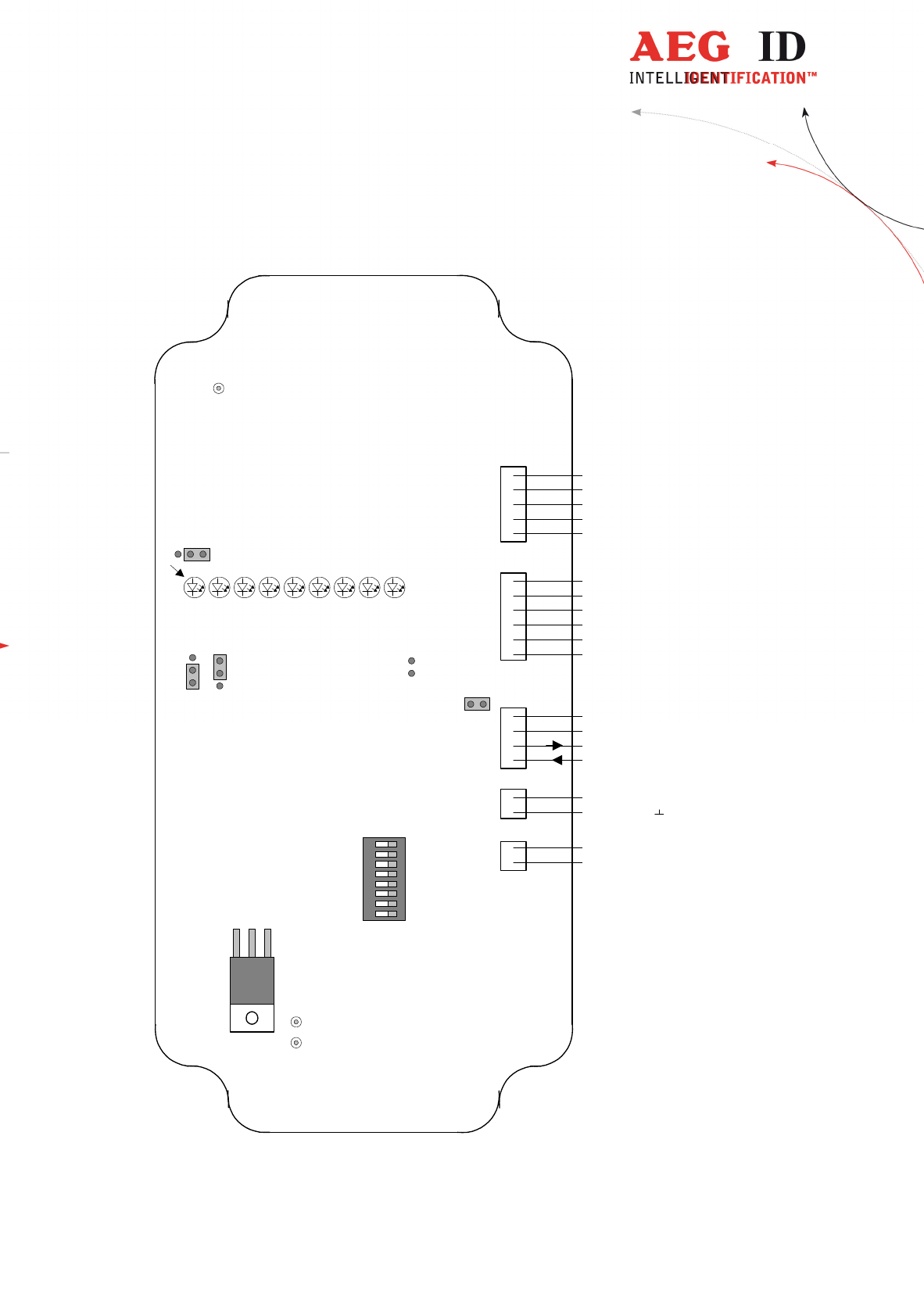
--------------------------------------------------------------------------------7/13--------------------------------------------------------------------------------
pin configuration of the PCB
X1
X2
X3
X4
X5
shielding
ground
TXD
RXD
1
2
3
4
5
6
make contact of relay QN1
1
2
3
4
5
data
shielding of data
sync
ground
12V
break contact of relay
QN1
1
2
1
224V
ground
LED1 - antenna
LED2 - no read
LED3 - read
LED4 - dig-input
LED5 - error
LED6 - power
LED7 - RxD
LED8 - TxD
LED9 - not used
relay QN1
make contact of relay QR1
relay QR1
break contact of relay
QR1
digital input +
digital input
On
12345678
DIP-Switch
TP4
JP5
JP1
JP2
JP3
JP4
+12V GND
3
4
1
2
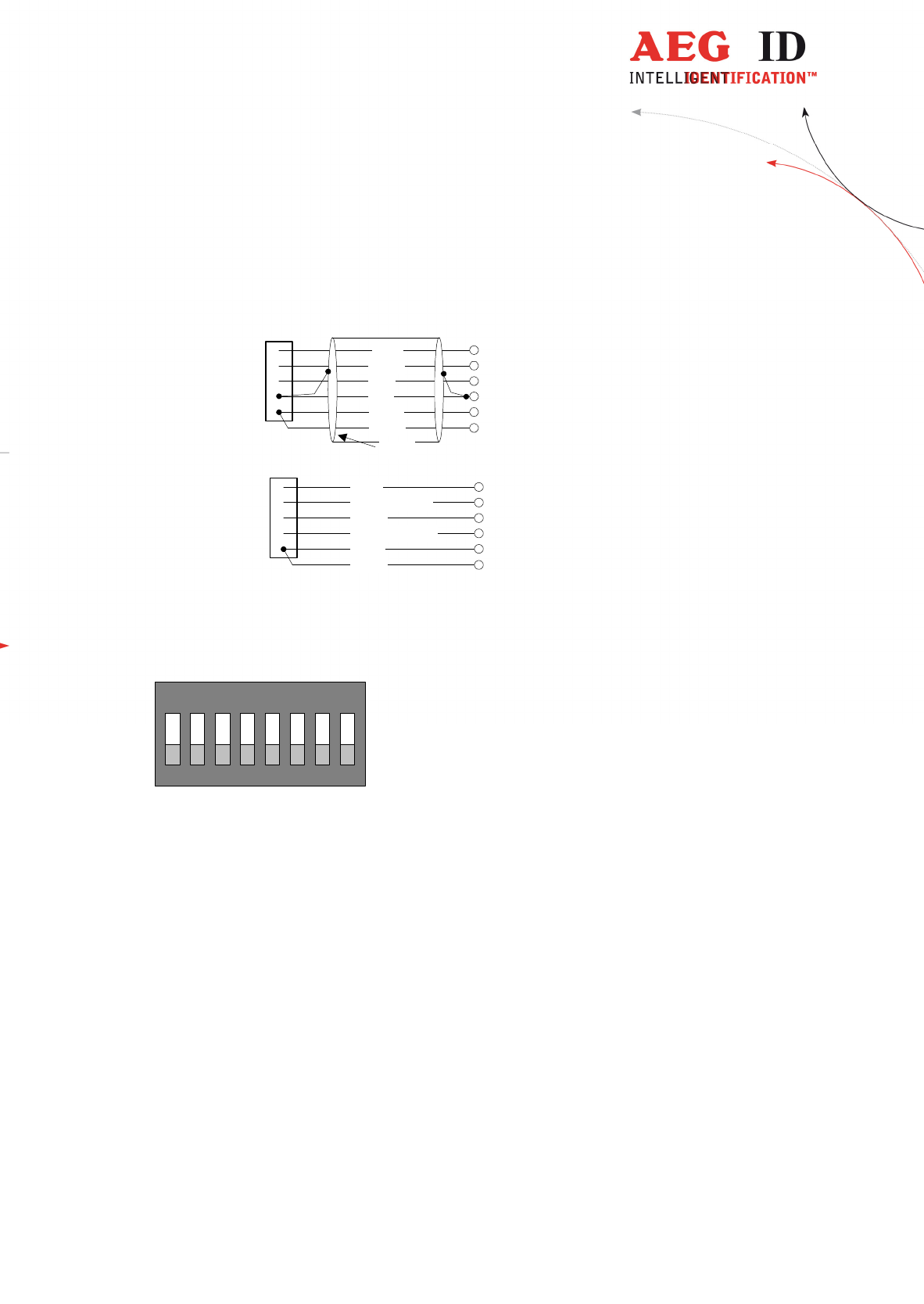
--------------------------------------------------------------------------------8/13--------------------------------------------------------------------------------
2.8 Pin Configuration of the terminal blocks (for antenna, power lines, etc.)
a) using LiY-LiYCY-Y 2+2x0,5 (delivered until march 2001)
b) using Li2YCY (TP) 3x2x0,34 (delivered from march 2001)
2.9 DIP-Switches
In normal condion (ex work) all DIP-switches are set OFF (down).
If switch 1 is in position ON, the default values (see chapter 3 - firmware) are loaded out of the EPROM at a
cold start (when reader is put in operation).
DIP-switches 2 ... 8 have no function.
2.10 LED´s
There are several LED’s inside of the reader housing on the PCB. The functions of these
LED’s are:
LED 1 on when antenna is operated.
LED 2 on when last read was not successful.
LED 3 on when last read was a success.
LED 4 on as long as the digital input is high.
LED 5 on when a hardware error was detected.
LED 6 flashing as long as the reader is powered and the microprocessor is working properly.
LED 7 on as long as commands were received on the RS 232 interface.
LED 8 on as long as information is transmitted from the RS.232 interface.
On
1 2 3 4 5 6 7 8
DIP-Switch
X1 - reader
antenna
connector
1
2
3
4
5
Data
Schirm
Sync
GND
12V
1
2
6
4
white
shield of white
brown
green
3
shield of brown
5
yellow
X1-reader
antenna
connector
1
2
3
4
5
data
shield
sync
GND
12
V
1
2
6
4
3
5
white
grey
green
yellow
brown
pink
shield
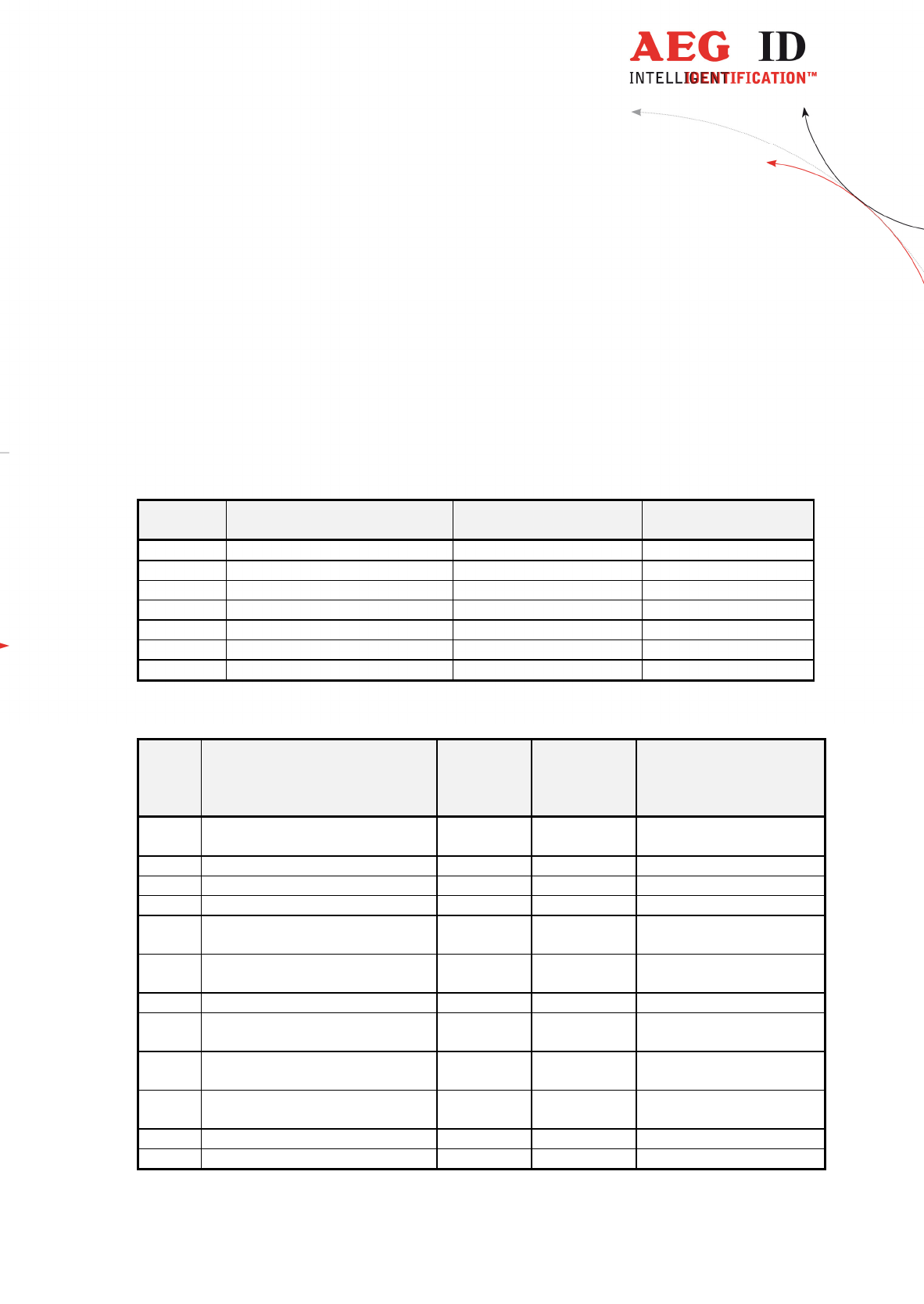
--------------------------------------------------------------------------------9/13--------------------------------------------------------------------------------
3 Firmware
The reader supports ASB (AEG ID standard set of instructions). When delivered the reader´s configuration is
set into the operation mode 2 (readings triggered by serial interface).
The reader can be set to the operation mode 0 (continuous operation) or to the operation mode 1 (triggered by
external input).
The parameters NRD and NID should only be changed after consulting the manufacturer.
The following commands are supported by the reader
command-
code
function action on interface Compability with
ASB1.0
DIAG
diagnosis / state of the reader
state or error message
no
GT
read transponder (get tag)
transponder number
yes
I
NIT
load basic configuration
boot message / <CR>
yes
RST
warm start
boot message / <CR>
yes
VER
Output version number
version number
yes
VS
Output of all parameter values
List of parameters
yes
VSAVE
store current configuration
ok
yes
The parameters which can be modified are:
com-
mand-
code
function universally
defined pa-
rameters
(ASB 1.0)
valid parame-
ter values for
ARE K1
default-values
MD mode of operation 0 .. 2 0 .. 2 2 (triggered by
interface)
BD
baud rate
0 .. 3
0 .. 3
2 (19200baud)
EC
ec
ho
0, 1
0, 1
0 (off)
CN
suppression of NoRead
0, 1
0 .. 2
0 (output FFFFFFFFFF)
CID filter function for multiply read
IDs
0, 1 0, 1 0 (filter off)
NID number of identical IDs per read-
ing cycle
0 , 1 0 , 1 1 (two out of two)
NRD
superimposition of t
elegrams
0 .. 2
0 .. 2
1 (two telegrams)
QN1 digital output QN1 0 .. 2 0 .. 2 2 (controlled by reading
process)
QR1 digital output QR1 0 .. 2 0 .. 2 2 (controlled by reading
process)
TOR timeout parameter for unsuccess-
full reading
0...9 0...255 5 (500ms)
ALGO
algorithm (type of transponder)
-
0 .. 2
1 (trovan read only)
PM
type of protocol
-
0, 1
0 (ASCII-protocol)
For more details please see the manual „Command Set for ARE K1“.
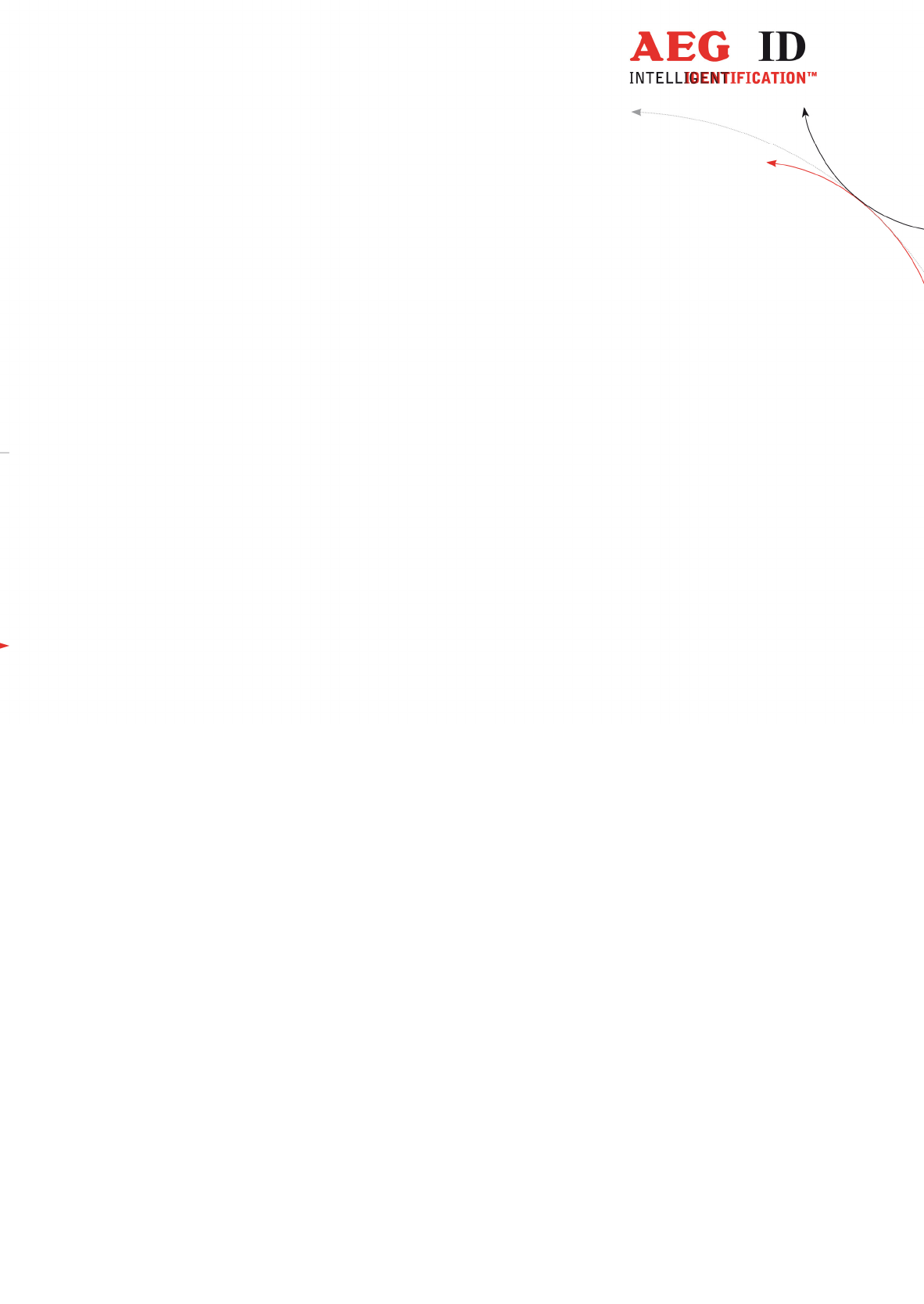
--------------------------------------------------------------------------------10/13--------------------------------------------------------------------------------
4 Putting into operation
4.1 Putting into operation for the first time
a) Connect the device to a 24 V DC source which is able to provide a minimum of 1 A. Connect the antenna with
the device. Connect a Personal Computer or equivalent to the device via the RS 232 interface. Please assure
the interface is set to the right baud rate.
b) Establish a connection to the reader (parameter: 19200 baud, 8N1) by using an appropriate software (for ex-
ample Windows terminal program). Test the configuration of the reader with the command VS.
c) If the device is in operating mode 2, each reading has to be startet using the GT command transmitted on the
serial interface. If the device is in operating mode 0, the scanner will send transponder numbers to the comput-
er, as long as a tranponder is in the active antenna field.
d) After the device is successfully tested as described above, you can set the reader configuration as needed. De-
tails how to change the configuration of the scanner are described in the ASB description.
4.2 Trouble shooting
Should the reader not work as desired, please check the following:
a) Is the configuration of the reader as wanted? Check with help of the command VS!
b) Is the configuration not known, the baud rates of reader and terminal set different?
Restore the basic setting of the parameters values as follows!
Put DIP-switch 1 ON, make a cold start by interrupting the power supply, put DIP-switch 1 OFF again. Now
all paramter values are set to the default values, the reader will work in normal condition. Attention! All set-
tings are temporary. This means they are lost after switching of the reader. Make the setting permanent using
the command VSAVE.
c) Is the antenna defect or not properly connected? (In that case LED 2 is not on although the reader is in read
mode)
d) The transponder is not in the active antenna field. Bring the transponder closer to the antenna.
e) Antenna mounting is wrong (for example on a metal plate). In such a case, it can happen that the radiated
antenna power is consumed by eddy currents in nearby metal structures. An indication for such situation is an
exceptional high current consumption of the reader.
Noise can also reduce the read range.
f) High frequency fields radiated by other devices interfere with the reader communication. Please check if such
devices are near to the antenna or the antenna cables. Typical devices which interfere on the reading range are
for example: some monitors for computers, switched power supplies, electrical motors, etc. Please remove such
devices or remove the radiated interferring filed by proper grounding.
g) If the mechanical configuration of metal pieceparts can not be changed and or not suitable for proper read-
ings. Please check, if with a different antenna better reading results can be obtained. Also electrical insulation
for metal parts against each other can help to reduce the eddy current effect.
f) If the noise resistance or reading frequency of the reader was reduced by changing the parameters NID or
NRD, please return the reader to the preset configuration of the manufacturer.
g) LED5 is on indicating an hardware failure. If a reset after checking all above points does not help return the
device for repair.
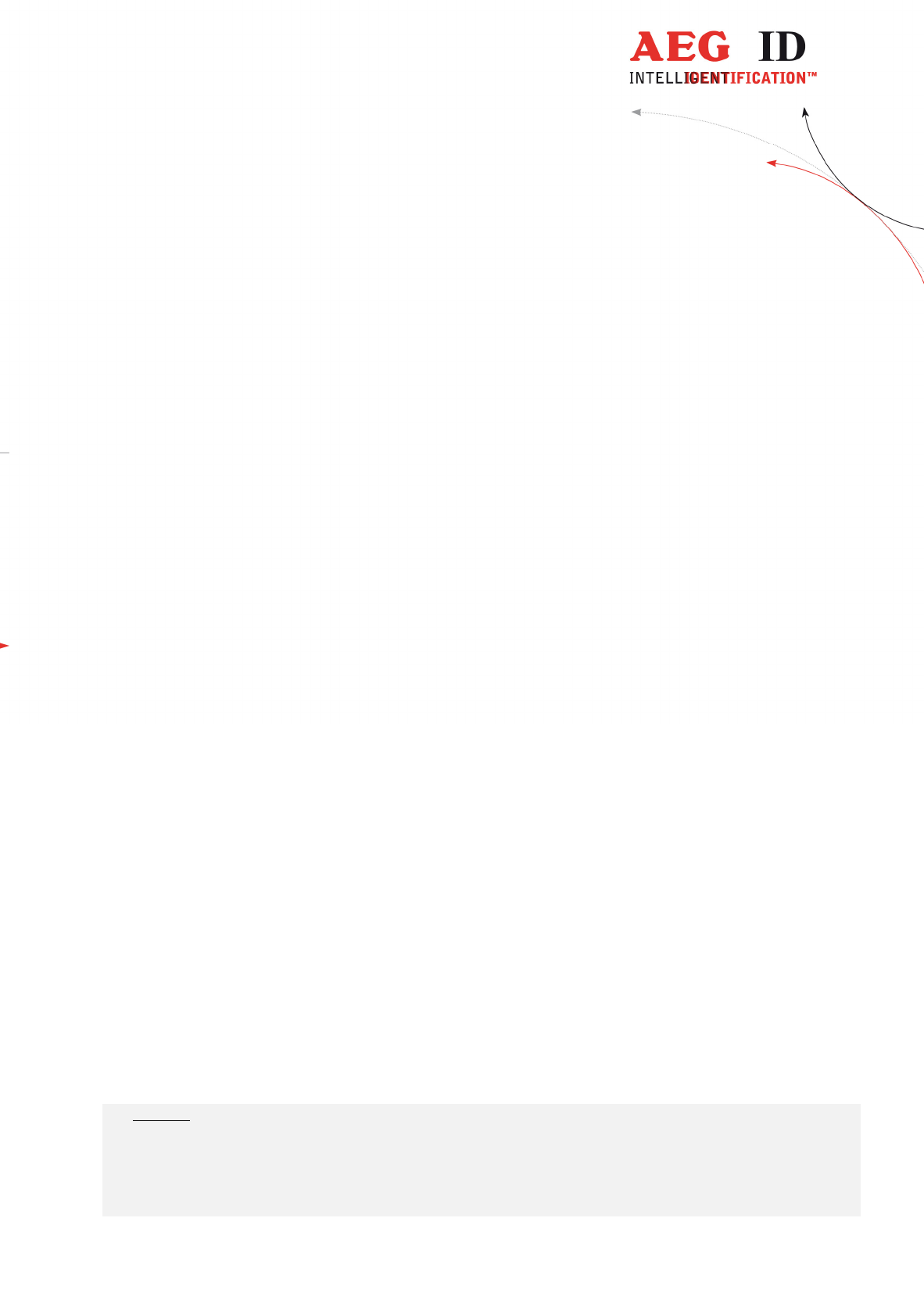
--------------------------------------------------------------------------------11/13--------------------------------------------------------------------------------
5 Antennas
The following antennas are suitable for this reader:
a) high power plate antenna AAN FK6 (only choice for USA)
b) high power plate antenna AAN FK2 / FK3
c) rod antenna AAN FK0
The reader with above antennas was tested against the requirements according
ETS 300683 and EN 55022 class B.
It is possible that antennas of other manufacturers may fit to the device. However, if connecting such non orig-
inal manufacturer antennas to the device, the warranty will get lost. Also a separate operation permission by
the local state administration might be required.
Special models
The standard device is equipped with an RS 232 interface.
On request there are special models available which support the interface with one of the following interfaces
instead of the RS 232:
- Modbus +
- Interbus S
- Profibus DP
- CAN
- RS485
6 Warnings and cautions
Υ When using the original AEG ID antennas suited for that device, the combination of antenna and reader have
the German permission for operation. Please check, if special permissions are required at the place of opera-
tion.
Υ This reader is an active electrical transmission system and radiates in the frequency range of approximately
124 kHz. When connecting a defect or a not suited antenna to the device the radiated power can be higher
than 42dBµA/m (measured at 10 m distance). The operator is responsible that people at risk are not end-
agered by the device.
Υ Do not operate the device with open housing, as otherwise there is a danger, that positions with dangerous volt-
age can be touched.
Υ Never operate the device with defect antenna cables. The antenna cables may conduct dangerous voltages.
When disconnecting an antenna cable please assure that the device is turned off and the cable was groundes for
a short time before touching it. Otherwise stored energy of the antenna may cause harm.
Υ The device should only be opened by trained personal when switched off.
Υ
ΥΥ
Υ Caution! Υ
ΥΥ
Υ
Never mount or place the antenna on extended metal parts. Do not bring another antenna very near at the
operated antenna (second antenna operated or not). In both cases there is a risk, that the antenna may be
destroyed. Such defects are not covered by the warranty.
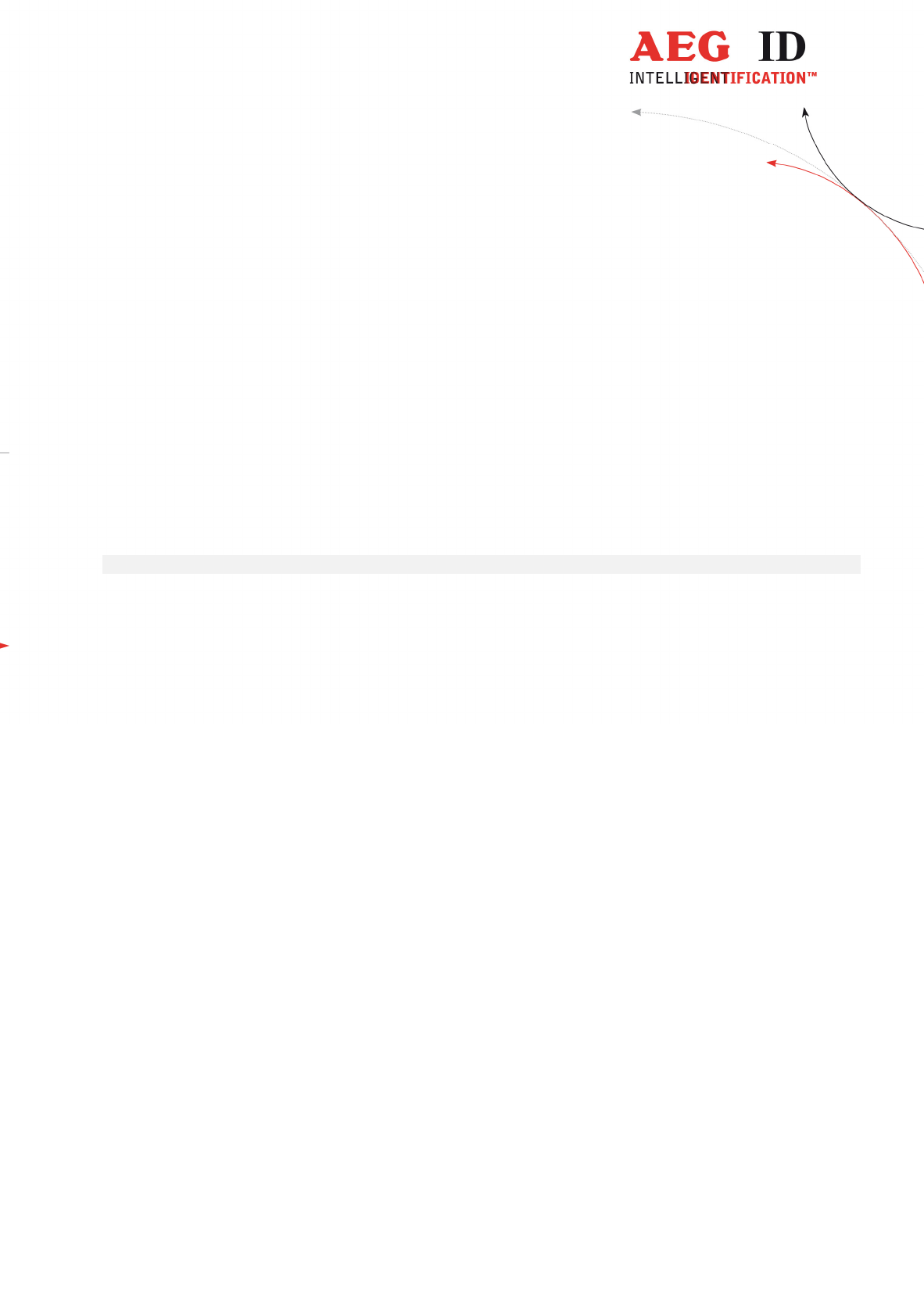
--------------------------------------------------------------------------------12/13--------------------------------------------------------------------------------
7 FCC Information
Federal Communications Commissions (FCC) Statement
15.21
You are cautioned that changes or modifications not expressly approved by the part responsible for compliance
could void the user’s authority to operate the equipment.
15.105(a)
This equipment has been tested and found to comply with the limits for a Class A digital de-vice, pursuant to Part
15 of the FCC Rules. These limits are designed to provide reasonable protection against harmful interference when
the equipment is operated in a commercial environment. This equipment generates, uses, and can radiate radio fre-
quency energy and, if not installed and used in accordance with the instruction manual, may cause harmful interfer-
ence to radio communications. Operation of this equipment in a residential area is likely to cause harmful interfer-
ence in which case the user will be required to correct the interference at his own expense.
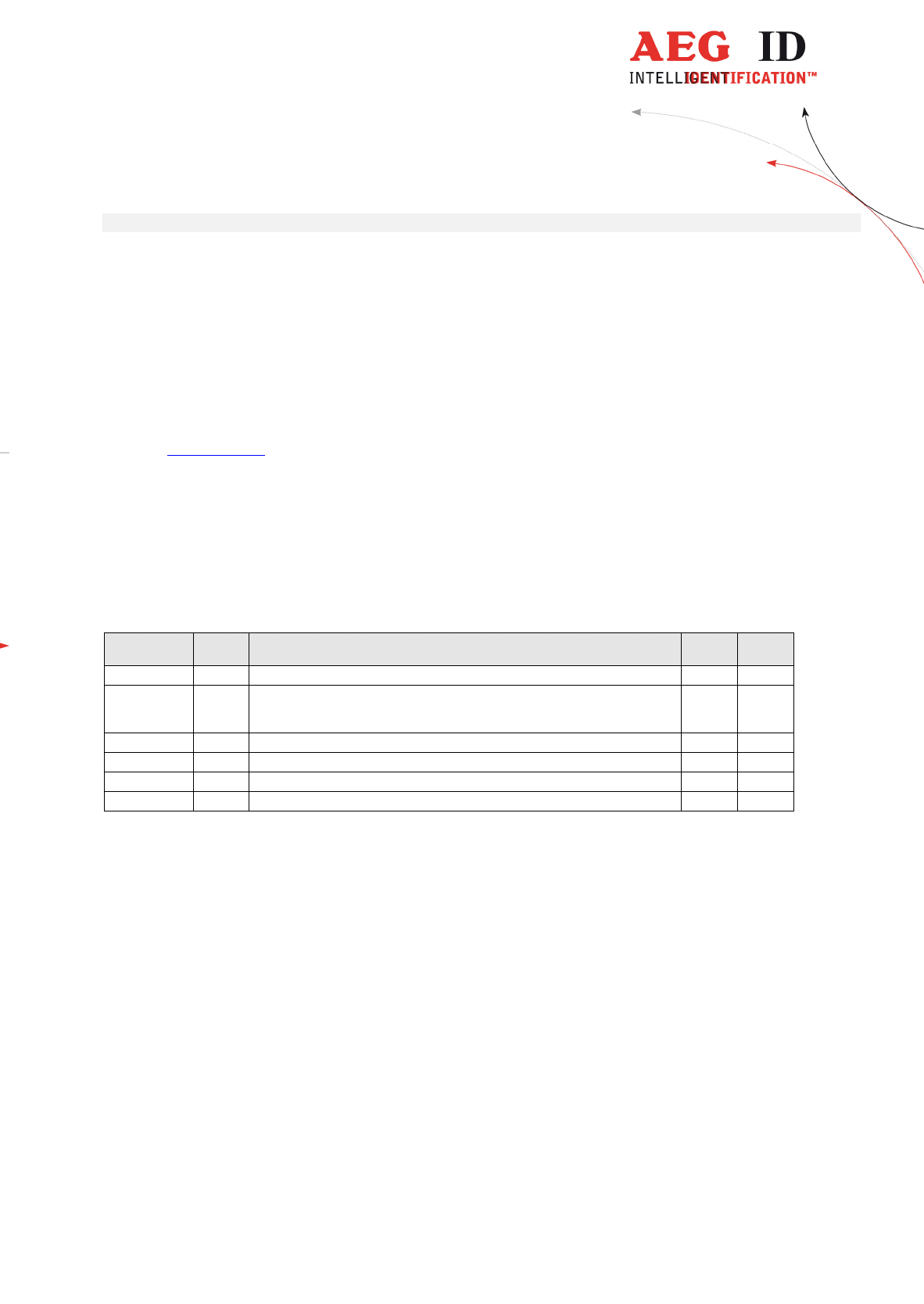
--------------------------------------------------------------------------------13/13--------------------------------------------------------------------------------
Copying of this document and giving it to others and the use or communication of the contents thereof, are forbidden without
express authority. Offender are liable to the payment of damages. All rights are reserved in the event of the grant of a patent or
the registration of a autility modul or design.
AEG Idenfikationssysteme GmbH
Hörvelsinger Weg 47
D-89081 Ulm
Tel: 0049-(0)731/140088-0
Fax: 0049-(0)731/140088-9000
e-mail : sales@aegid.de
www.aegid.de
8 notification of changes
change no date description of change version editor
10/01 08/22.01
• connection of serial interface
• operating mode ex work now MD2
• supplemetation: commands ALGO and PM
06
10.08.10
• Format 07
05/18/16
• FCC Information 08
06/22/16
• FCC Information correction 09 MK
10/05/16
• FCC Information correction 10 MK